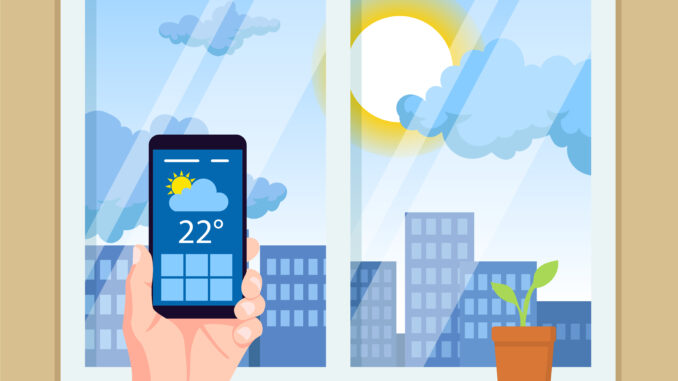
One product of science and technology that is useful on a daily basis is weather forecasting. For instance, knowing the weather can help an office worker decide what to wear to his daily commute or empower a farmer to create an effective irrigation schedule. The aviation and maritime industries all rely on reliable weather forecasts, such as the NOAA marine weather forecast, to operate. Solar energy farms or solar power stations, which harvest power from the sun, enable consistent weather checks, so power system operators can take early calculated actions in case of extreme weather changes. Climate forecasting can also help the average joe plan outdoor activities, such as garden weddings or family backyard barbecues.
Given the significant impact of the weather on people’s lives, it’s important to know what things to consider when looking at weather forecasts. Here are some points to check out. Points to Consider About Weather Forecasts
- Persistence is vital for short-term weather forecasts
The weather condition today will most likely be the same tomorrow. This most straightforward method is often used for short-term predictions. For example, if weather conditions vary little from day to day in a specific area, then it’s likely that the previous day’s conditions can be used to predict the next day’s weather. So if it’s sunny today, short-term planning for outdoor activities tomorrow should be fine.
- When a chance of rain doesn’t simply mean “a chance of rain”
A meteorologist doesn’t just make a failsafe guess on whether or not it will rain. Forecasting the “chance of rain” involves numerous atmospheric processes and mathematical computations. The official formula for the “chance of rain” or percentage of precipitation (from the National Oceanic and Atmospheric Administration) goes as follows: PoP = C X A, “where C is the confidence percentage and A is the percentage of the area with precipitation.”
A 100% certainty that it will rain in 40% of an area will result in a 40% POP. The issue here is that science is never 100% sure, and this can create a lot of interpretations.
One POP interpretation could go like this: a 40% chance of rain may simply mean a 4 in 10 chance that it would rain within the forecast period. But it could also mean that 40% of a given area would experience rain within the forecast period. For some specific workforce groups required to be in different locations during the day, this would be a crucial factor to take note of.
Interpretations may vary, but people don’t need to fret over finding the exact science in POPs. If people misinterpret them, it should not be a big issue. Getting wet is the worst thing that can happen if you don’t bring your handy dandy umbrella. It would be critical to remember that meteorologists are more concerned with monitoring storms, tornadoes, and hurricanes, which can threaten people’s lives and have more far-reaching consequences.
- Snowfall forecasts are more often wrong than right
Snow is trickier to forecast than rain. Meteorologists are often tormented with snow prediction because the most minor changes can significantly affect the snow system. Though computer models have improved in accuracy over time, a more intricate process is involved in snowfall prediction. Ground-level temperatures, together with much higher atmospheric temperatures, are additional factors that are considered.
Snow is basically water plus air. The amount of water plus how the water acts as it drops are observed. What starts as snow in the atmosphere can fall as snow or rain, particularly freezing rain. Snow is definitely fun in the right amounts and when it falls at the right time, yet it can be annoying or even frustrating when it loses its charm. Tedious snow clearing pesters people, especially when they need to hurry to go to work.
- Don’t take warnings lightly
Weather forecasting can save lives and property. People in a storm’s pathway are told to prepare for the worst. Citizens are advised to stock up on basic necessities or are asked to evacuate and take shelter in safer areas in extreme situations. Property and crop damage are reduced when early warnings are given, as people are given time to take the necessary precautions.
Some familiar warnings issued are about tornadoes, thunderstorms, and high winds.
A tornado warning tells people affected to go to safer areas, such as basements. A thunderstorm warning advises people to disconnect unused electrical appliances and stay indoors as soon as possible. It is also recommended not to have any activity using water, such as bathing and doing the laundry, as lightning can travel through a building’s plumbing system. Similar to the two previous types of warnings, a high wind warning alerts people to find sturdy shelter away from windows and glass doors.
Always heed the warnings of weather forecasts as safety should always come first. Remember that warnings are only given when the weather is imminent or already taking place.
- Check the reliability of your mobile weather apps
With the convenience of smartphones, people unmindfully grab their phones and navigate through the weather forecast on any given random application. Some might even have multiple applications to ensure they get consistent predictions. However, many of these weather forecast apps don’t agree with each other most of the time. There are several reasons for this. One, each application may come from different sources. Another reason is that different meteorologists use various computer models. The subject location may still be the same, but some forecasts may be more precise than others.
There’s nothing wrong with using your mobile weather apps. Just remember to determine which ones are more reliable based on customer reviews. In any case, it’s wise to always be prepared. Keep your weather “tools,” such as an umbrella, raincoat, or cold-weather clothes handy in the trunk of your car, so you’re ready regardless of the weather forecast accuracy.







Leave a Reply